warning Citroen JUMPER 2008 2.G Owner's Guide
[x] Cancel search | Manufacturer: CITROEN, Model Year: 2008, Model line: JUMPER, Model: Citroen JUMPER 2008 2.GPages: 163, PDF Size: 2.76 MB
Page 76 of 163
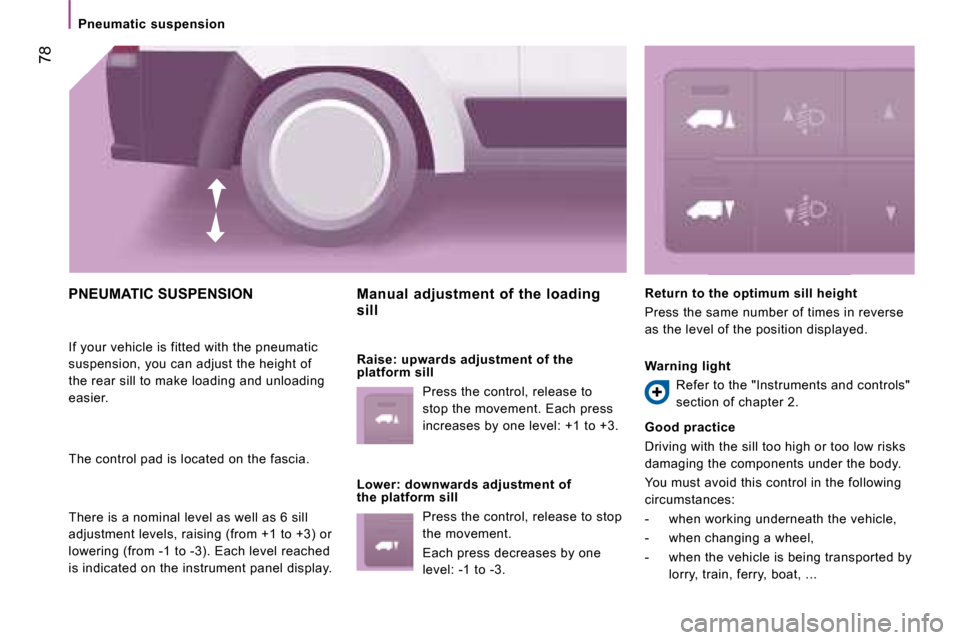
78
Pneumatic suspension
PNEUMATIC SUSPENSION
If your vehicle is fitted with the pneumatic
suspension, you can adjust the height of
the rear sill to make loading and unloading
easier.
The control pad is located on the fascia.
There is a nominal level as well as 6 sill
adjustment levels, raising (from +1 to +3) or
lowering (from -1 to -3). Each level reached
is indicated on the instrument panel display. Manual adjustment of the loading
sill
Raise: upwards adjustment of the
platform sill
Press the control, release to
stop the movement. Each press
increases by one level: +1 to +3.
Lower: downwards adjustment of
the platform sill Press the control, release to stop
the movement.
Each press decreases by one
level: -1 to -3. Return to the optimum sill height
Press the same number of times in reverse
as the level of the position displayed.
Warning light
Refer to the "Instruments and controls"
section of chapter 2.
Good practice
Driving with the sill too high or too low risks
damaging the components under the body.
You must avoid this control in the following
circumstances:
- when working underneath the vehicle,
- when changing a wheel,
- when the vehicle is being transported by lorry, train, ferry, boat, ...
Page 99 of 163
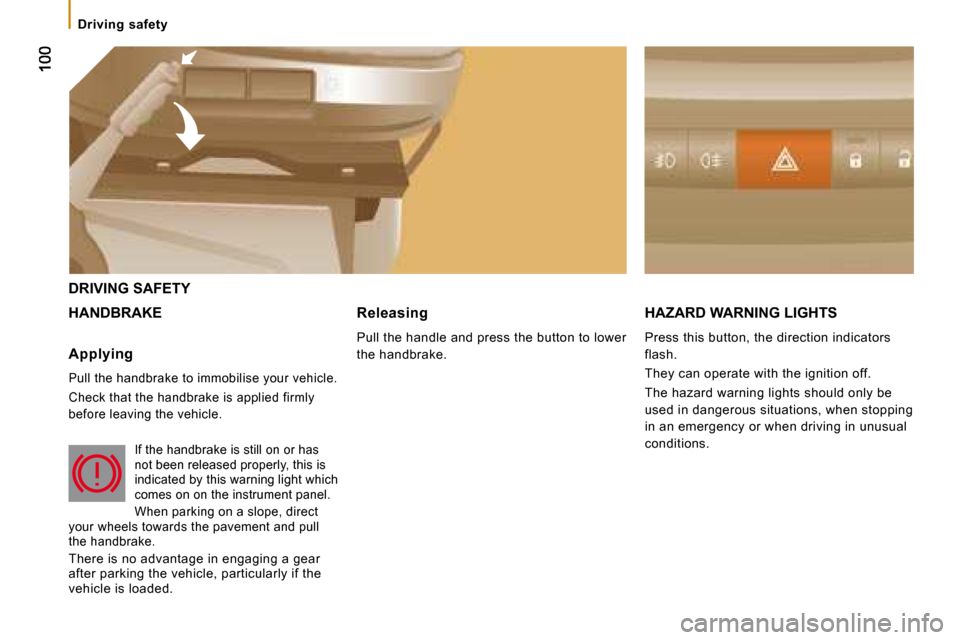
Driving safety
DRIVING SAFETY
HANDBRAKE HAZARD WARNING LIGHTS
Press this button, the direction indicators
flash.
They can operate with the ignition off.
The hazard warning lights should only be
used in dangerous situations, when stopping
in an emergency or when driving in unusual
conditions.
Applying
Pull the handbrake to immobilise your vehicle.
Check that the handbrake is applied firmly
before leaving the vehicle.
If the handbrake is still on or has
not been released properly, this is
indicated by this warning light which
comes on on the instrument panel.
When parking on a slope, direct
your wheels towards the pavement and pull
the handbrake.
There is no advantage in engaging a gear
after parking the vehicle, particularly if the
vehicle is loaded. Releasing
Pull the handle and press the button to lower
the handbrake.
Page 100 of 163
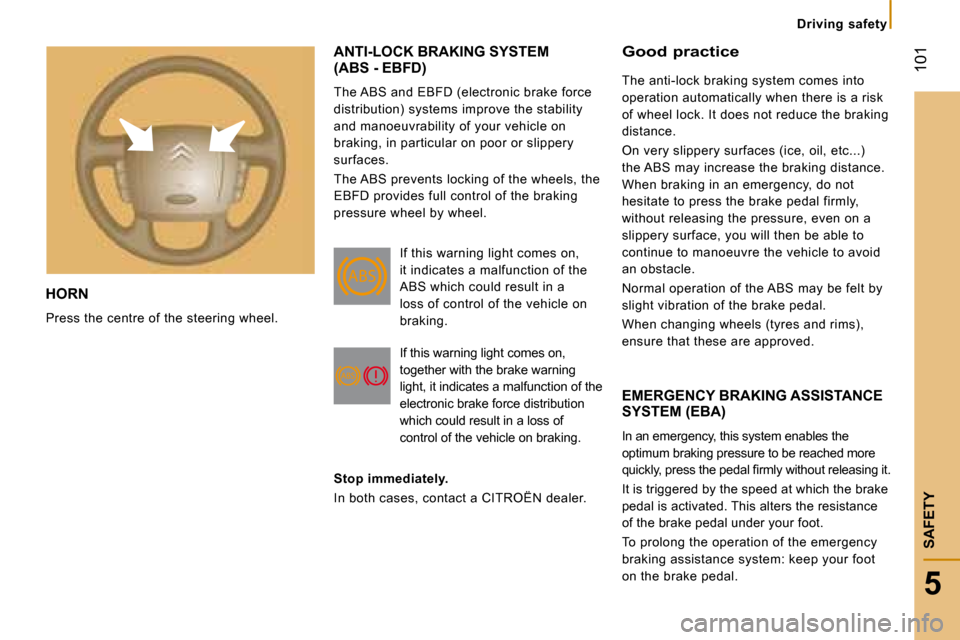
101
5
SAFETY
Driving safety
HORN
Press the centre of the steering wheel.
ANTI-LOCK BRAKING SYSTEM (ABS - EBFD)
The ABS and EBFD (electronic brake force
distribution) systems improve the stability
and manoeuvrability of your vehicle on
braking, in particular on poor or slippery
surfaces.
The ABS prevents locking of the wheels, the
EBFD provides full control of the braking
pressure wheel by wheel.
EMERGENCY BRAKING ASSISTANCE SYSTEM (EBA)
In an emergency, this system enables the
optimum braking pressure to be reached more
�q�u�i�c�k�l�y�,� �p�r�e�s�s� �t�h�e� �p�e�d�a�l� �fi� �r�m�l�y� �w�i�t�h�o�u�t� �r�e�l�e�a�s�i�n�g� �i�t�.� �
It is triggered by the speed at which the brake
pedal is activated. This alters the resistance
of the brake pedal under your foot.
To prolong the operation of the emergency
braking assistance system: keep your foot
on the brake pedal.
Good practice
The anti-lock braking system comes into
operation automatically when there is a risk
of wheel lock. It does not reduce the braking
distance.
On very slippery surfaces (ice, oil, etc...)
the ABS may increase the braking distance.
When braking in an emergency, do not
hesitate to press the brake pedal firmly,
without releasing the pressure, even on a
slippery surface, you will then be able to
continue to manoeuvre the vehicle to avoid
an obstacle.
Normal operation of the ABS may be felt by
slight vibration of the brake pedal.
When changing wheels (tyres and rims),
ensure that these are approved.
If this warning light comes on,
it indicates a malfunction of the
ABS which could result in a
loss of control of the vehicle on
braking.
If this warning light comes on,
together with the brake warning
light, it indicates a malfunction of the
electronic brake force distribution
which could result in a loss of
control of the vehicle on braking.
Stop immediately.
In both cases, contact a CITROËN dealer.
Page 101 of 163
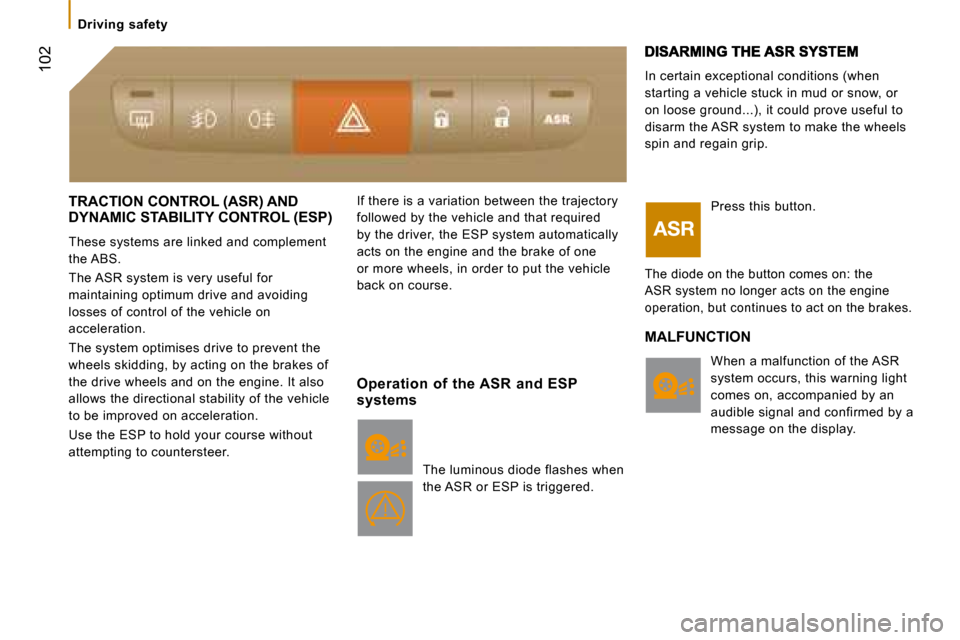
102
Driving safety
TRACTION CONTROL (ASR) AND DYNAMIC STABILITY CONTROL (ESP)
These systems are linked and complement
the ABS.
The ASR system is very useful for
maintaining optimum drive and avoiding
losses of control of the vehicle on
acceleration.
The system optimises drive to prevent the
wheels skidding, by acting on the brakes of
the drive wheels and on the engine. It also
allows the directional stability of the vehicle
to be improved on acceleration.
Use the ESP to hold your course without
attempting to countersteer. If there is a variation between the trajectory
followed by the vehicle and that required
by the driver, the ESP system automatically
acts on the engine and the brake of one
or more wheels, in order to put the vehicle
back on course.
In certain exceptional conditions (when
starting a vehicle stuck in mud or snow, or
on loose ground...), it could prove useful to
disarm the ASR system to make the wheels
spin and regain grip.
Operation of the ASR and ESP
systems The luminous diode flashes when
the ASR or ESP is triggered. Press this button.
The diode on the button comes on: the
ASR system no longer acts on the engine
operation, but continues to act on the brakes.
MALFUNCTION
When a malfunction of the ASR
system occurs, this warning light
comes on, accompanied by an
audible signal and confirmed by a
message on the display.
Page 102 of 163
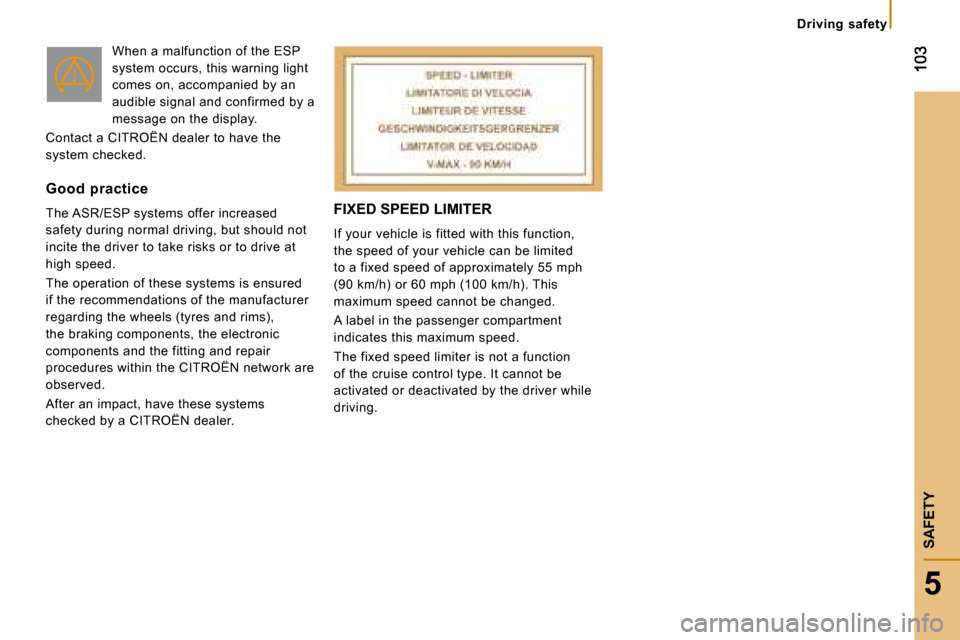
5
SAFETY
Driving safety
FIXED SPEED LIMITER
If your vehicle is fitted with this function,
the speed of your vehicle can be limited
to a fixed speed of approximately 55 mph
(90 km/h) or 60 mph (100 km/h). This
maximum speed cannot be changed.
A label in the passenger compartment
indicates this maximum speed.
The fixed speed limiter is not a function
of the cruise control type. It cannot be
activated or deactivated by the driver while
driving.
When a malfunction of the ESP
system occurs, this warning light
comes on, accompanied by an
audible signal and confirmed by a
message on the display.
Contact a CITROËN dealer to have the
system checked.
Good practice
The ASR/ESP systems offer increased
safety during normal driving, but should not
incite the driver to take risks or to drive at
high speed.
The operation of these systems is ensured
if the recommendations of the manufacturer
regarding the wheels (tyres and rims),
the braking components, the electronic
components and the fitting and repair
procedures within the CITROËN network are
observed.
After an impact, have these systems
checked by a CITROËN dealer.
Page 103 of 163
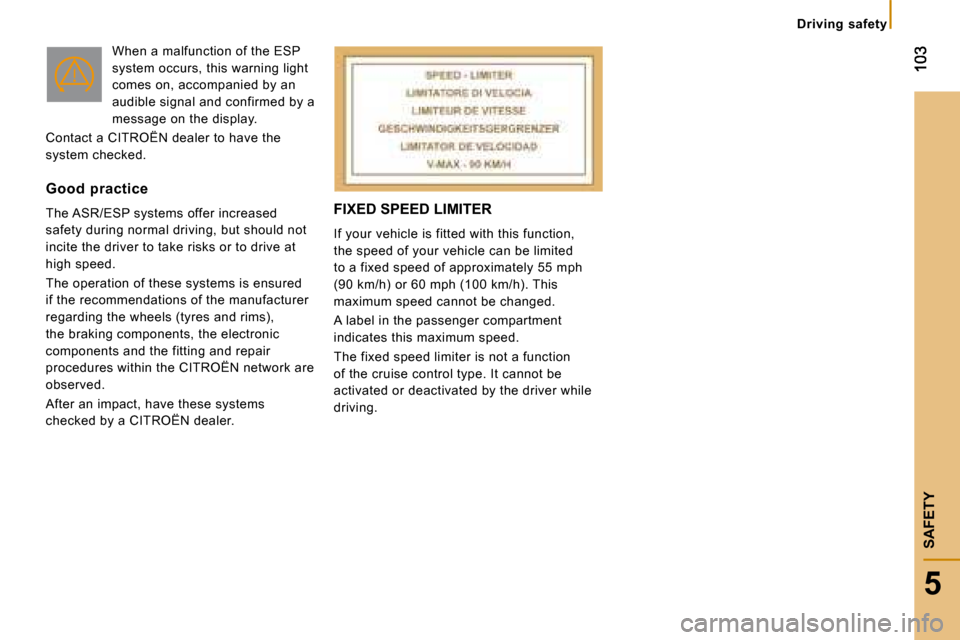
5
SAFETY
Driving safety
FIXED SPEED LIMITER
If your vehicle is fitted with this function,
the speed of your vehicle can be limited
to a fixed speed of approximately 55 mph
(90 km/h) or 60 mph (100 km/h). This
maximum speed cannot be changed.
A label in the passenger compartment
indicates this maximum speed.
The fixed speed limiter is not a function
of the cruise control type. It cannot be
activated or deactivated by the driver while
driving.
When a malfunction of the ESP
system occurs, this warning light
comes on, accompanied by an
audible signal and confirmed by a
message on the display.
Contact a CITROËN dealer to have the
system checked.
Good practice
The ASR/ESP systems offer increased
safety during normal driving, but should not
incite the driver to take risks or to drive at
high speed.
The operation of these systems is ensured
if the recommendations of the manufacturer
regarding the wheels (tyres and rims),
the braking components, the electronic
components and the fitting and repair
procedures within the CITROËN network are
observed.
After an impact, have these systems
checked by a CITROËN dealer.
Page 104 of 163
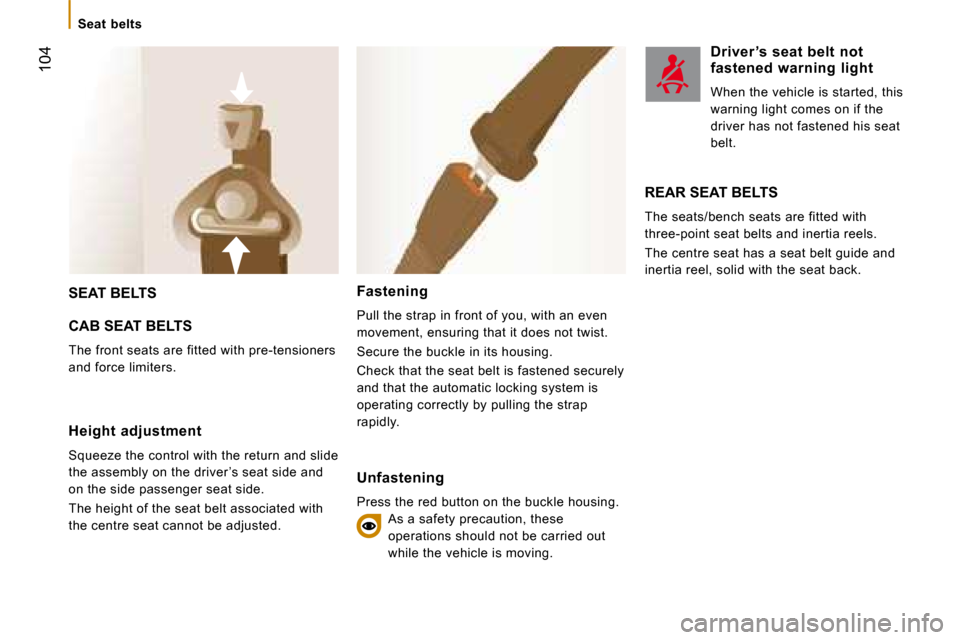
SEAT BELTS
CAB SEAT BELTS
The front seats are fitted with pre-tensioners
and force limiters.
REAR SEAT BELTS
The seats/bench seats are fitted with
three-point seat belts and inertia reels.
The centre seat has a seat belt guide and
inertia reel, solid with the seat back.
Height adjustment
Squeeze the control with the return and slide
the assembly on the driver ’s seat side and
on the side passenger seat side.
The height of the seat belt associated with
the centre seat cannot be adjusted. Fastening
Pull the strap in front of you, with an even
movement, ensuring that it does not twist.
Secure the buckle in its housing.
Check that the seat belt is fastened securely
and that the automatic locking system is
operating correctly by pulling the strap
rapidly.
Unfastening
Press the red button on the buckle housing.
As a safety precaution, these
operations should not be carried out
while the vehicle is moving. Driver ’s seat belt not
fastened warning light
When the vehicle is started, this
warning light comes on if the
driver has not fastened his seat
belt.
Seat belts
104
Page 105 of 163
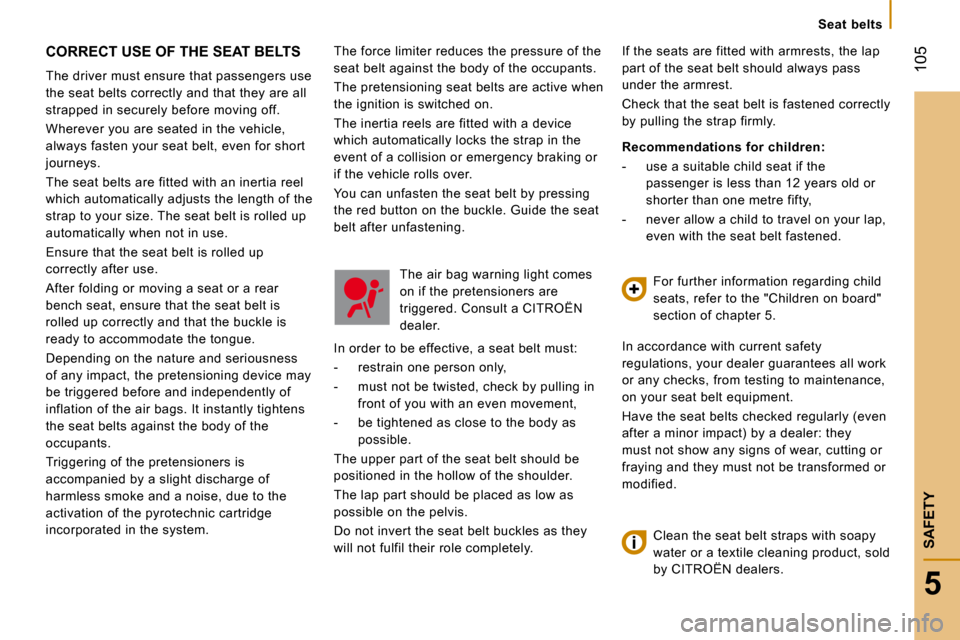
The force limiter reduces the pressure of the
seat belt against the body of the occupants.
The pretensioning seat belts are active when
the ignition is switched on.
The inertia reels are fitted with a device
which automatically locks the strap in the
event of a collision or emergency braking or
if the vehicle rolls over.
You can unfasten the seat belt by pressing
the red button on the buckle. Guide the seat
belt after unfastening. CORRECT USE OF THE SEAT BELTS
The driver must ensure that passengers use
the seat belts correctly and that they are all
strapped in securely before moving off.
Wherever you are seated in the vehicle,
always fasten your seat belt, even for short
journeys.
The seat belts are fitted with an inertia reel
which automatically adjusts the length of the
strap to your size. The seat belt is rolled up
automatically when not in use.
Ensure that the seat belt is rolled up
correctly after use.
After folding or moving a seat or a rear
bench seat, ensure that the seat belt is
rolled up correctly and that the buckle is
ready to accommodate the tongue.
Depending on the nature and seriousness
of any impact, the pretensioning device may
be triggered before and independently of
inflation of the air bags. It instantly tightens
the seat belts against the body of the
occupants.
Triggering of the pretensioners is
accompanied by a slight discharge of
harmless smoke and a noise, due to the
activation of the pyrotechnic cartridge
incorporated in the system. The air bag warning light comes
on if the pretensioners are
triggered. Consult a CITROËN
dealer.
In order to be effective, a seat belt must:
- restrain one person only,
- must not be twisted, check by pulling in front of you with an even movement,
- be tightened as close to the body as possible.
The upper part of the seat belt should be
positioned in the hollow of the shoulder.
The lap part should be placed as low as
possible on the pelvis.
Do not invert the seat belt buckles as they
will not fulfil their role completely. If the seats are fitted with armrests, the lap
part of the seat belt should always pass
under the armrest.
Check that the seat belt is fastened correctly
by pulling the strap firmly.
Recommendations for children:
- use a suitable child seat if the
passenger is less than 12 years old or
shorter than one metre fifty,
- never allow a child to travel on your lap, even with the seat belt fastened.
For further information regarding child
seats, refer to the "Children on board"
section of chapter 5.
In accordance with current safety
regulations, your dealer guarantees all work
or any checks, from testing to maintenance,
on your seat belt equipment.
Have the seat belts checked regularly (even
after a minor impact) by a dealer: they
must not show any signs of wear, cutting or
fraying and they must not be transformed or
modified.
Clean the seat belt straps with soapy
water or a textile cleaning product, sold
by CITROËN dealers. 105
5
SAFETY
Seat belts
Page 107 of 163

AIR BAGS
The air bags have been designed to
maximise the safety of the occupants in the
event of a serious collision; they work in
conjunction with the force limiting seat belts.
In the event of a serious collision, the
electronic detectors record and analyse any
abrupt deceleration of the vehicle:
if the triggering threshold is reached, the
air bags inflate instantly and protect the
occupants of the vehicle.
Immediately after the impact, the air bags
deflate rapidly, so that they do not hinder the
visibility of the occupants nor their possible
exit from the vehicle. The air bags will not be deployed in
collisions which are not serious, for
which the seat belt is sufficient to provide
maximum protection. The seriousness of
the collision depends on the nature of the
obstacle and the speed of the vehicle at the
moment of impact.
Air bags only operate when the ignition is
switched on. Front air bags
These are folded in the centre of the steering
wheel for the driver and in the fascia for
the front passenger. They are deployed
simultaneously, except in cases where the
passenger air bag has been disarmed.
The gas escaping from the deployed
air bags can be a minor irritant.
The noise of the detonation may result in a
slight loss of hearing for a short time. Front air bag malfunction
If this warning light comes on,
contact a CITROËN dealer to
have the system checked.
5
SAFETY
Air bags
Page 108 of 163
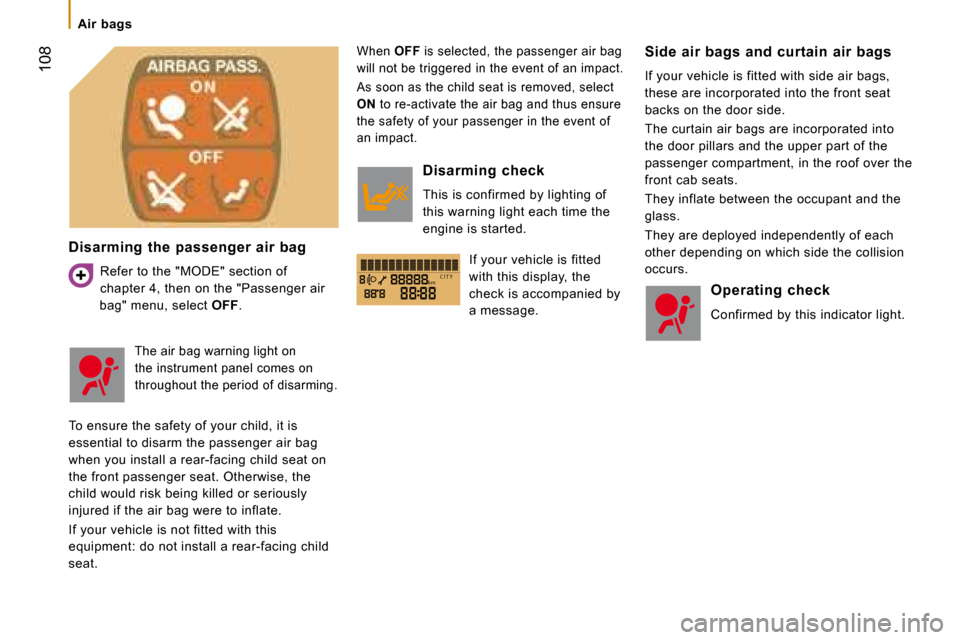
kmC I T Y
108
Disarming the passenger air bag Refer to the "MODE" section of
chapter 4, then on the "Passenger air
bag" menu, select OFF .
When OFF is selected, the passenger air bag
will not be triggered in the event of an impact.
As soon as the child seat is removed, select
ON to re-activate the air bag and thus ensure
the safety of your passenger in the event of
an impact. Side air bags and curtain air bags
If your vehicle is fitted with side air bags,
these are incorporated into the front seat
backs on the door side.
The curtain air bags are incorporated into
the door pillars and the upper part of the
passenger compartment, in the roof over the
front cab seats.
They inflate between the occupant and the
glass.
They are deployed independently of each
other depending on which side the collision
occurs.
The air bag warning light on
the instrument panel comes on
throughout the period of disarming.
To ensure the safety of your child, it is
essential to disarm the passenger air bag
when you install a rear-facing child seat on
the front passenger seat. Otherwise, the
child would risk being killed or seriously
injured if the air bag were to inflate.
If your vehicle is not fitted with this
equipment: do not install a rear-facing child
seat. Disarming check
This is confirmed by lighting of
this warning light each time the
engine is started.
If your vehicle is fitted
with this display, the
check is accompanied by
a message. Operating check
Confirmed by this indicator light.
Air bags